No. 6 Effects of α-CD on Lipid Lowering in LDLr-KO Mice
"Effects of Alpha-Cyclodextrin on Lipid Lowering in Mice." Experimental Biology 2007
Abstract
Alpha-cyclodextrin(α-CD), a new soluble fiber, has been shown to bind with fat, thus reducing the absorption of dietary fat. It also reduces blood lipid levels and prevents body weight gain in rats fed a high-fat diet. In order to investigate the efficacy of α-CD in reducing the blood cholesterol (C) levels and possibly atherogenic lesion development in a common mouse model of atherosclerosis, female low density lipoprotein receptor knock-out (LDLr-KO) mice, 10 wks old, were divided into the high-fat "western" diet (CON, 21.2% milk fat w/w , n=10) or the same diet with 2.12% α-CD (α-CD, n=10) groups. After 10 wks ad-lib feeding, mice were fasted for 6 h and blood samples collected by retro-orbital bleeding. Food intake and body weight were the same in the 2 groups. Compared to CON mice, mice fed the α-CD diet showed significant reductions in blood total C (-14%, 30.5±3.7 vs. 26.2±3.7 mmol/l, p<.05); phospholipids (-11%, 16.3±1.8 vs. 14.4±1.8mmol/l, p<.05); free C (-15.9%, 9.0±1.1 vs. 7.6±1.4 mmol/l, p<.05) and C ester (-13.3%, 21.5±2.5 vs. 18.7±2.5 mmol/l, p<.05). Fasting triglyceride levels were not different between the 2 groups. FPLC data showed that the reduction in C levels was mainly in the pro-atherogenic LDL containing fractions. Therefore, in an animal model of hypercholesterolemia due to the lack of the LDL receptor, α-CD demonstrated its efficacy in reducing the blood cholesterol and its components. Oral α-CD may be an effective treatment for hypercholesterolemia.
Methods
Animals
- 20 female LDLr-KO mice, 10 weeks old at the beginning of the study, were purchased from Jackson Laboratory (Bar Harbor, ME). They were housed in polycarbonate hanging cages with 5 mice/cage.
- All mice were fed a rodent diet (NIH31, 4% fat, 0.02% Cholesterol, Zeigler Bros Inc., Gardner, PA) prior to the beginning of the study, and were watered ad-lib throughout the study.
- Fasting blood samples (4-6 hrs) were taken from retro-orbital sinus before randomly assigning the mice to Control or α-CD groups.
- Fasting blood samples were taken after 2, 5, 10 and 14 weeks of feeding the respective diets.
- Body weight was measured daily.
- Food intake was evaluated on 5 consecutive days.
Diet
- Control diet: Modified Diet (Harlan Teklad 'Western diet' TD.88137) with milk fat as the fat source
・21% (W/W) as fat, 0.2% cholesterol
・4.5 kcal/g - α-CD diet: Same as Control diet with 21g/kg of α-CD (10% of fat) replacing an equal amount of cellulose
・4.5 kcal/g - Milk fat fatty acid profile:
・Saturated fats: 65%
・Monounsaturated fats: 31%
・Polyunsaturated fats: 4%
Chemical Analyses
- Plasma lipids: Determined by enzymatic assays.
- Lipoprotein fractions: Separated by FPLC, and fractions were analyzed for lipid content as above.
- Fatty acid composition of plasma: Analyzed by Gas-Chromatography method of Redel et al. (1998).
Statistical Analyses
- Student's t-tests were conducted. Significant level was set at p<0.05.
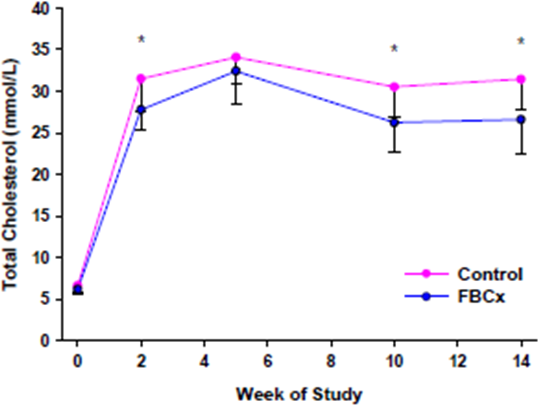
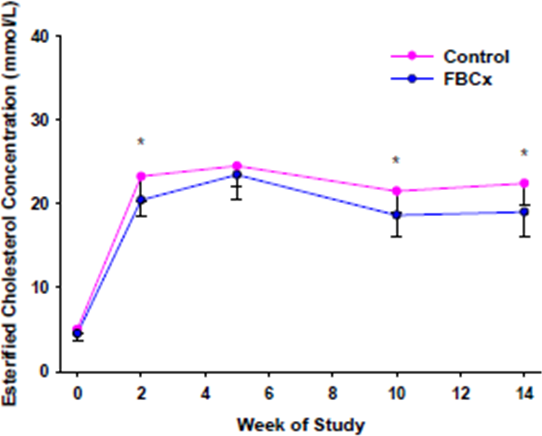
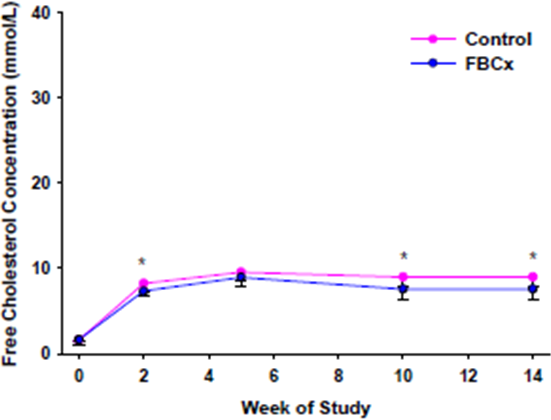
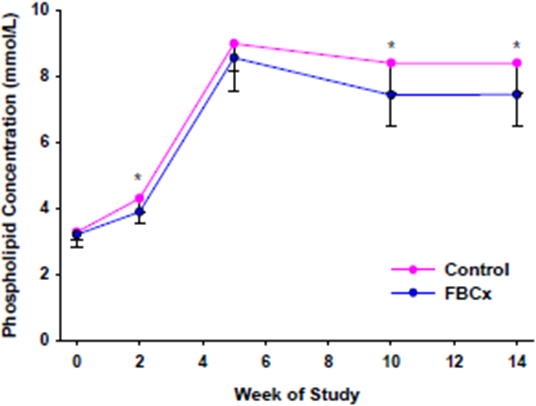


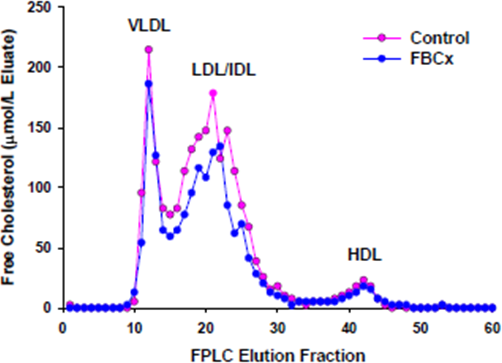
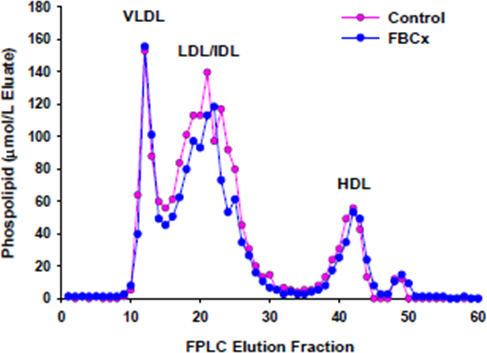
Change In Plasma Fatty Acid Components FBCx-Control
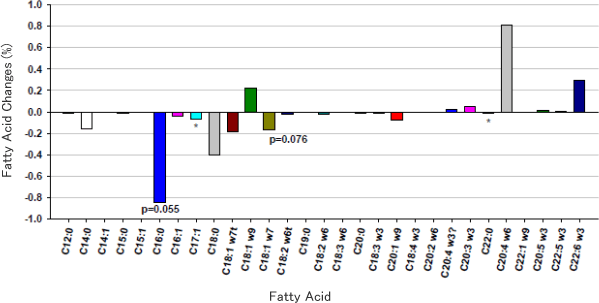
Change In Plasma Lipid Levels
Week 14 - Baseline
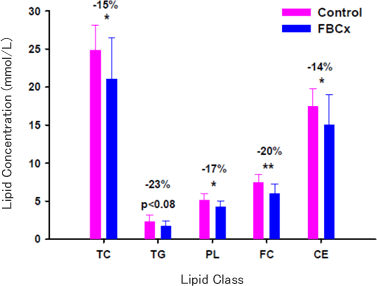
Discussion
Relative to the Control animals, when α-CD was added to the diet of the LDLr-KO mice:
- There was no effect on either body weight or food consumption.
- There were significant reductions in the increase in plasma total cholesterol (-15%), esterified cholesterol (-14%), free cholesterol (-19.8%) and phospholipids (-17.5%).
- There was a reduction in the increase in plasma triglyceride level, although not significant (23%, p<0.08).
- These reductions were observed within 2 weeks of initiating the α-CD containing diet.
- The reduction in total cholesterol was primarily in the pro-atherogenic VLDL/LDL/IDL fractions.
- There was no significant change in the HDL fractions.
- The plasma fatty acid profile changed. The main changes included reductions in the saturated fatty acids (palmatic, stearic and cis-vaccenic acids) and increases in unsaturated fatty acids (oleic, arachidonic and docosahexaenoic acids).
Conclusions
- The soluble dietary fiber α-CD is efficacious in reducing blood cholesterol in the pro-atherogenic VLDL, LDL and IDL lipoprotein fractions while leaving the anti-atherogenic HDL lipoprotein levels unchanged.
- The soluble dietary fiber α-CD appears to improve the blood fatty acid profile by preferentially decreasing the trans and saturated relative to unsaturated fatty acids.
- Addition of α-CD to the diet at a rate of 10% of dietary fat (w/w) may be beneficial to the management of hyperlipidemia and possibly reducing the risk of developing cardiovascular disease.
